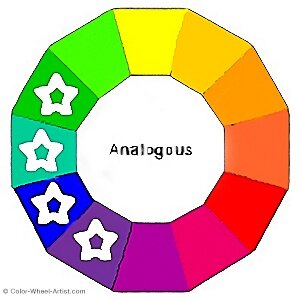Color meanings can be quite subjective. Everyone reacts differently but there are general feelings and moods common to everyone.
Have you ever wondered why people are attracted to certain colors? Or why your favorite color isn't universally loved by everyone you know?

- Share
- Tweet
- Share
- Share
- Pin
Category Archives for Color Schemes
Meanings of Colors
Monochromatic Color Schemes – Color Theory and Painting Tips

A Monochromatic Color Scheme, in theory, is defined by the use of only one Hue on the Basic Color Wheel.
Practically speaking, it's possible to use various different pigments of the same Hue. For example you could paint with Quinacridone Red plus Alizarin Red, and it would still be considered a Monochromatic Color Scheme. That's because they are both in the Red Hue family.
However, how do you vary this one color to make it interesting, even if you are using different versions of it?
Analogous Color Schemes: Color Theory and Painting Tips

Analogous Colors are defined by selecting any three or more Hues on a Basic Color Wheel. By comparison to other color schemes, there are no spaces between Analogous Colors.
As a result of these Hues being so close together, it means they are generally in the same relative family of colors. Therefore, just like any close family, this fact can be both a blessing and a challenge.
Triad Color Schemes – Color Theory and Painting Tips

A Triad Color Scheme traditionally uses three Hues that are evenly spaced around the Color Wheel. Above, you can see every fourth color has been selected, leaving three colors between each.
Of course there are other types of Triad Color Schemes such as the Complementary Triad and Modified Triad. However, here we are taking a look at the most basic. Once you've mastered this traditional Triad Color Scheme, the others are simple to use. Let me show you how three colors can help you create harmony in any creative project.
Complementary Color Schemes – Color Theory and Painting Tips

Complementary Colors are any two Hues positioned exactly opposite each other on the Basic Color Wheel. To be sure, knowing where they lie on a Color Wheel is basic. But even more important, is understanding what this means in a practical sense.
Keep reading to learn how these pairs of colors can help you create more interesting mixtures for your projects.